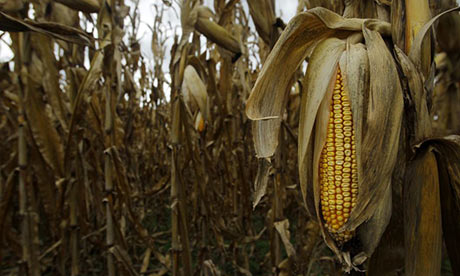Environment & Energy
Related: About this forumNOAA: Climate change did not cause historic 2012 U.S. drought

"The historic drought that blazed across America's corn belt last year was not caused by climate change, a federal government study found.
The summer of 2012 was the driest since record-keeping began more than a century ago, as well as one of the hottest, producing drought conditions across two-thirds of the continental United States.
Barack Obama and other prominent figures have repeatedly cited the drought as evidence of climate change. But the report released on Thursday by scientists at five different government agencies said that was not the case. The drought was "a sequence of unfortunate events" that occurred suddenly, the report said. The circumstances were so unusual the drought could never have been predicted."
http://www.guardian.co.uk/environment/2013/apr/12/climate-change-not-2012-drought
Report
snappyturtle
(14,656 posts)pscot
(21,024 posts)Bold added.
http://www.wunderground.com/blog/JeffMasters/show.html
kristopher
(29,798 posts)The report looked at the Central Plains Drought and asked whether it was an expansion of the Texas drought and if its direct origins were of a nature that would cause us to expect drought in that region as a chronic condition going forward(a new and changed climate).
Dr. Trenberth is welcome to his opinion, it has some merit. I would expect him to now undertake another examination asking the questions that HE wants to examine.
here is their summary: http://www.drought.gov/media/pgfiles/callouts.pdf
Posted in full:
Text in Callout Boxes from
An Interpretation of the Origins of the 2012 Central Great Plains Drought Assessment Report
• This report describes the morphology of the 2012 summer U.S. central Great Plains drought, placing the event into a historical context, and providing a diagnosis of its proximate and underlying causes.
• Absent were the usual abundance of slow soaking rain systems and evening thunderstorms that characterize Great Plains climate from May through August, and as a result surface moisture conditions greatly deteriorated.
• It is expected that water supply reductions in the semi-arid western portions of the drought where reservoir storage was depleted by lack of rains will also have long-term impacts, as will livestock health and its long term effect on herd stocks.
• The 2012 crop yield deficit and the implied climatic impact was a historic event. In terms of absolute loss in bushels of corn production, no single year since 1866 experienced so large a curtailment as occurred during 2012.
• Summertime Great Plains rainfall has been in an upward trend since the early 20th Century, and the last major drought occurred 25 years ago in 1988. The 2012 drought thus was a —climate surprise—, and would not have been anticipated from simple considerations of central U.S. rainfall behavior in the recent past.
• The Central Plains drought of 2012 was not a progression or northward creeping of the prior year’s Southern Plains drought event. There were no strong indicators that an extreme drought event was poised to spread over the Central Plains in 2012.
• As is common with droughts, atmospheric moisture in both absolute and relative measures is typically deficient, and 2012 was no exception. A second, and often inexorably linked factor is the absence of processes that produce rainfall over the central Plains.
• Underlying causes refer to root causes, within a chain of factors, that lead to an outcome. Climate scientists are especially interested in identifying such causes because they can entail useful long-lead predictability. The report examines sea surface temperature (SST) and sea ice conditions, and also the chemical composition of the atmosphere, as potential underlying causes for the drought over the central Plains in summer 2012.
• Climate simulations and empirical analysis suggest that neither ocean surface temperatures nor changes in greenhouse gases induced a substantial reduction in summertime precipitation over the central Great Plains during 2012. Diagnosis of historical data, climate simulation data, and seasonal forecasts paint a picture of an extreme drought that may not have had extreme forcing as its cause and that had limited long lead predictability.
• It is a speculative yet an intriguing conjecture that, while perhaps unbeknownst and undetectable from the observations, the recent 10-15 year period may have been one of heightened risk for the occurrence of a record setting summer drought over the central Great Plains.
• Experimental methods are being studied that offer some hope for improved prediction, at least for short lead times, of drought conditions such as occurred in 2012.
• The interpretation of the 2012 drought as rendered in this report of the NOAA Drought Task Force raises, and in part helps to answer, several science challenges including questions on improving applicability and utility of drought infomation.
• The use of both climate and forecast models in interpreting the 2012 central Plains drought is a promising approach for explaining event causes with a goal to improve forecasts and forecasting practices.
• There is need for further research to better understand how oceans and land surface conditions are related to regional climate that can induce drought. Sustained monitoring, integrated with advanced modeling methods, offer hope for improved drought outlooks in the future.